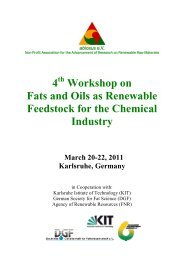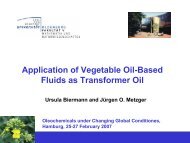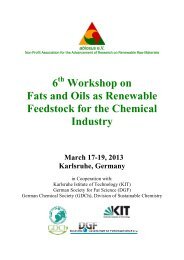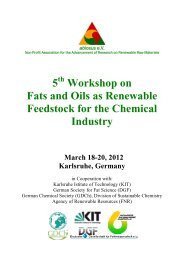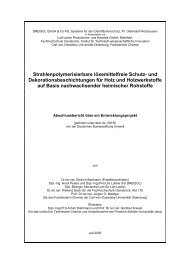Fats and Oils as Renewable Feedstock for the Chemical ... - abiosus
Fats and Oils as Renewable Feedstock for the Chemical ... - abiosus
Fats and Oils as Renewable Feedstock for the Chemical ... - abiosus
You also want an ePaper? Increase the reach of your titles
YUMPU automatically turns print PDFs into web optimized ePapers that Google loves.
L3Utilization of fatty acid derivatives in <strong>the</strong> development ofbio-b<strong>as</strong>ed chemicalsChristian V. StevensDepartment of Organic Chemistry - Center of <strong>Renewable</strong> Resources, Faculty ofBioscience Engineering, Ghent University, Coupure Links 653, B-9000 Ghent, Belgium.E-mail: Chris.Stevens@UGent.beIn <strong>the</strong> l<strong>as</strong>t decade, renewable resources are getting more attention in view of <strong>the</strong>ir positiveeffects on <strong>the</strong> sustainability of processes, <strong>the</strong> reduction of greenhouse g<strong>as</strong> emissions <strong>and</strong><strong>the</strong> opportunities to develop biofuels. Especially, <strong>the</strong> research <strong>and</strong> <strong>the</strong> production of bioethanol<strong>and</strong> biodiesel is <strong>the</strong> major topic when talking about renewables. However, <strong>the</strong>production of biomaterials <strong>and</strong> bio-b<strong>as</strong>ed building blocks <strong>for</strong> <strong>the</strong> chemical industry, whichwill be <strong>the</strong> major challenge in <strong>the</strong> long run, is getting much less attention. There<strong>for</strong>e, it isessential to invest in studying <strong>the</strong> production of bio-materials <strong>and</strong> building blocks <strong>for</strong> <strong>the</strong>future in a multidisciplinary way.The SynBioC (Syn<strong>the</strong>sis <strong>and</strong> Bioresources Chemistry) group is recently engaged in <strong>the</strong>production of bio-b<strong>as</strong>ed building blocks from c<strong>as</strong>tor oil. Undecenoic acid can be readilyobtained by a <strong>the</strong>rmal treatment under vacuum of ricinoleic acid, which composes 85-95 %of <strong>the</strong> c<strong>as</strong>tor oil. Undecenoic acid h<strong>as</strong> been dimerised by an acyloin condensation to apolyfunctional building block of which <strong>the</strong> reactivity <strong>and</strong> usefulness is now being evaluated.The C22-building block h<strong>as</strong> been trans<strong>for</strong>med into a C-20 tetrachlorodiacid which is used<strong>as</strong> a building block <strong>for</strong> <strong>the</strong> syn<strong>the</strong>sis of <strong>the</strong> aminopeptid<strong>as</strong>e inhibitor Tyromycin A. Thesyn<strong>the</strong>sis of <strong>the</strong> bio-b<strong>as</strong>ed building blocks on route to Tyromycin A will be discussed.Fur<strong>the</strong>r work in our group h<strong>as</strong> been focused on <strong>the</strong> chemistry of inulin. Inulin, <strong>the</strong>polydisperse reserve polysaccharide from chicory, h<strong>as</strong> been modified by carbamoylation<strong>and</strong> esterification in organic solvents to develop a variety of modified inulin derivativesfrom which <strong>the</strong> interfacial <strong>and</strong> emulsion stabilizing properties were determined. Themedium <strong>and</strong> long chain acylated/carbamoylated inulin derivatives, with low degrees ofsubstitution (DS), showed a good to very good reduction of <strong>the</strong> interfacial tension whichmakes <strong>the</strong>se biopolymers interesting in <strong>the</strong> field of biodegradable emulsifying agents.Inutec SP1 h<strong>as</strong> been developed in collaboration with industry <strong>as</strong> a new <strong>and</strong> highper<strong>for</strong>ming emulsifying agent <strong>for</strong> <strong>the</strong> cosmetic industry, <strong>as</strong> well <strong>as</strong> <strong>for</strong> <strong>the</strong> latex industry.12



